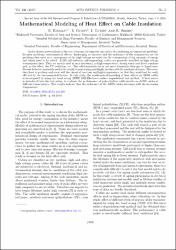| dc.contributor.author | Eroğlu, Emre | |
| dc.contributor.author | Güney, I. | |
| dc.contributor.author | Güneş, I. | |
| dc.contributor.author | Şener, E. | |
| dc.date.accessioned | 2021-12-12T17:02:49Z | |
| dc.date.available | 2021-12-12T17:02:49Z | |
| dc.date.issued | 2017 | |
| dc.identifier.issn | 0587-4246 | |
| dc.identifier.issn | 1898-794X | |
| dc.identifier.uri | https://doi.org/10.12693/APhysPolA.131.539 | |
| dc.identifier.uri | https://hdl.handle.net/20.500.11857/3543 | |
| dc.description | 6th Congress and Exhibition on International Advances in Applied Physics and Materials Science (APMAS) -- JUN 01-03, 2016 -- Istanbul, TURKEY -- | en_US |
| dc.description.abstract | In the electric power industry, the cost of energy, its longevity and safety of transferring are important problems. Security problems, environmental effects, discharging occurrences and the endurance of the transporters are the problems that exist as a consequence of the high voltage necessity for the transmission of big amounts of energy and which need to be solved. ADSS (all dielectric self-supporting) cables are generally installed on high voltage transmission lines. They are mostly used in such situations, as high temperature, strong winds and direct sunshine and, as the effect, the UV radiation, etc. The solid materials are in use more frequently than gas or liquid ones. Decent dielectric materials need to be sturdy to puncturing and highly invulnerable for mechanical issues. Moreover, they have to perform and resist well the chemical reactions and high temperature, so that they would not be easily effected by the environmental factors. In this study, the mathematical modeling of heat effects on ADSS cables is investigated by using dry band arcing (IEEE 1222 Electrical surface degradation) test method. A heat source is introduced into the test setup, to evaluate the performance of poly-ethylene cable jackets on ADSS cables at different temperatures. Test results indicate that the endurance of the ADSS cables decreases with the increasing temperature. | en_US |
| dc.description.sponsorship | Kirklareli UniversityKirklareli University [KUBAP 009]; Uludag UniversityUludag University [UAP(F)-2010/18] | en_US |
| dc.description.sponsorship | This study was supported by Kirklareli University (KUBAP 009) and Uludag University (UAP(F)-2010/18). | en_US |
| dc.language.iso | eng | en_US |
| dc.publisher | Polish Acad Sciences Inst Physics | en_US |
| dc.relation.ispartof | Acta Physica Polonica A | en_US |
| dc.identifier.doi | 10.12693/APhysPolA.131.539 | |
| dc.rights | info:eu-repo/semantics/openAccess | en_US |
| dc.subject | Systems | en_US |
| dc.title | Mathematical Modeling of Heat Effect on Cable Insulation | en_US |
| dc.type | proceedingsPaper | |
| dc.authorid | Sener, Ersin/0000-0002-5934-3652 | |
| dc.authorid | Guney, ibrahim/0000-0001-8290-6532 | |
| dc.authorid | GUNES, Ibrahim/0000-0003-1032-1134 | |
| dc.department | Fakülteler, Fen-Edebiyat Fakültesi, Matematik Bölümü | |
| dc.identifier.volume | 131 | en_US |
| dc.identifier.startpage | 539 | en_US |
| dc.identifier.issue | 3 | en_US |
| dc.identifier.endpage | 541 | en_US |
| dc.relation.publicationcategory | Konferans Öğesi - Uluslararası - Kurum Öğretim Elemanı | en_US |
| dc.authorscopusid | 8280033200 | |
| dc.authorscopusid | 36912189400 | |
| dc.authorscopusid | 56781244200 | |
| dc.authorscopusid | 57194089749 | |
| dc.identifier.wos | WOS:000400905500055 | en_US |
| dc.identifier.scopus | 2-s2.0-85018719443 | en_US |
| dc.authorwosid | Sener, Ersin/AAS-8204-2021 | |
| dc.authorwosid | Guney, ibrahim/ABF-8301-2020 | |
| dc.authorwosid | GUNES, Ibrahim/C-6981-2019 | |



















